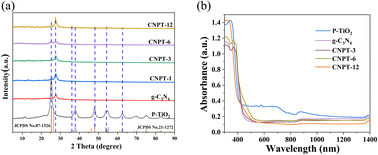Direct Z-scheme P–TiO2/g-C3N4 heterojunction for the photocatalytic degradation of sulfa antibiotics†
Abstract
The construction of direct Z-scheme heterojunctions with high photocatalytic degradation ability is important for wastewater treatment, but there are still many unsolved challenges. In this article, we report the fabrication of a Z-scheme P–TiO2/g-C3N4 (CNPT-X) heterostructure by the calcination method. Under simulated sunlight, CNPT-X composites are found to show excellent degradation performance against sulfonamide antibiotics sulfadiazine (SD), sulfamethazine (SM2), sulfamonomethoxine (SMM), and sulfamethoxazole (SMZ). CNPT-3 (400 mg L−1) can be used to degrade four sulfa antibiotics within 90 min, with a degradation rate as high as 99%, which is higher than that for P–TiO2 and g-C3N4 alone. The internal electron transfer paths and mechanisms for the composites are revealed by ESR radical detection experiments, XPS energy spectrum shifts, valence band positions and active material quenching experiments. Furthermore, the degradation products are analyzed by GC-MS, and four possible degradation pathways for sulfonamide pollutants are proposed. This photocatalyst provides new insights into the fundamental aspects of the photocatalytic degradation mechanism for composite pollutants, as well as new ideas for practical environmental applications.



 Please wait while we load your content...
Please wait while we load your content...